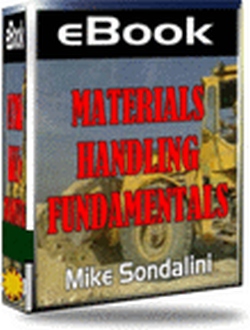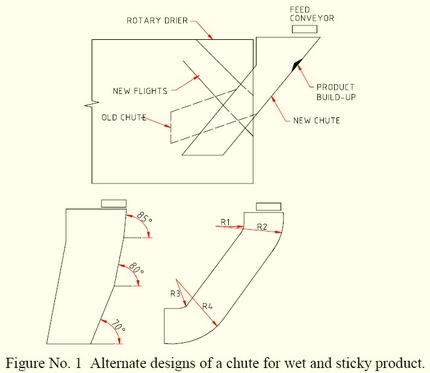Bulk Material Handling
Bulk Material Handling Equipment Systems Design PDF
By Mike Sondalini

The Bulk Material Handling Equipment Systems Design whitepaper PDF is a great introduction for both maintenance and students studying bulk material handling engineering. Although most applications are dry, this whitepaper includes a section on open trickle chutes for wet and sticky products too! This whitepaper is 32 pages.
Those who follow Mike's works will notice there is a lot of overlap between this PDF and Mike's one that details 'Belt Bucket Elevator Design - 2nd edition'. As the bucket elevator is one of the most common types of bulk material handling equipment. As dry material is also the most common application, dust control is also covered in great detail.

Over a period of days and various product changes, the walls and base of the chute became coated in built up material from the accumulated splatter of damp product as it flowed through the chute. Though thick build up was present it did not stop product flow. Provided the product developed sufficient momentum it continued to move down the coated chute. The presence of the splattered product negated the benefit of using stainless sheeting and confirmed the importance of designing chutes with sufficient incline to produce flow. Figure No. 1 shows a sketch of the installation along with sketches of other possible solutions to the problem.
Bulk Material Handling Equipment Systems Design - Contents:
Bucket elevator experiences.
Bucket elevators lift bulk materials from one level to another. They are used on powders, granules, grain, chip-shaped products, and lumpy materials. They function well when designed properly for the duty, and used as designed. Problems that can occur and possible remedies are noted.
Bulk material handling chute design.
For the effective flow of damp, cohesive (sticks to itself) products, a bulk material handling chute design must be designed to maintain momentum. A sufficient inclination is critical.
Tracking large rotating material handling equipment.
Rotary dryers, kilns, mills, and reactors turn on tires and trunnions. Each tire is mounted to the rotating shell and revolves on two roller trunnions. If the alignment between the tire and trunnions is lost due to wear, poor repair, installation error, or impact, the equipment will need to be tracked.
Bulk material handling conveyors: Belt tuning.
A belt conveyor is a moving surface used to transport products from one end to the other. In its basic form, it consists of a driving head pulley, a tail pulley, a moving belt, support rollers, cleaning devices, tensioning mechanisms, and a structural frame. Though simple in concept its many components need to work together as a system to get the best performance and operating life. Critical to that is an understanding of how to care for a belt conveyor and tune it for successful operation.
Tracking belts on elevators and conveyors.
Flexible flat belts are used on bucket elevators and belt conveyors to carry loose bulk products. The belt is stretched tight from the head drum to the tail drum and the friction generated on the turning head drum is used to drive the belt and carry the product. The belt must run true on the end pulleys (drums) and stay within the sides of the equipment structure. If the belt runs off the drums, buckets will be destroyed and belt edges frayed. In the worst cases, the belt runs off the pulleys resulting in a breakdown repair. Proper and long-lived tracking of belts is critical for trouble-free operation.
Protecting bearings in dusty places.
Protecting bearing from dust. Protection methods like labyrinth rings, rubber seals, felt seals, and shaft mechanical seals are described. The choice of the appropriate shaft seal and seal configurations to protect against dust ingress is critical. Numerous shaft seal designs suited to dusty conditions are reviewed.
Cyclone separators, low-cost particle removal.
A cyclone separator is used to separate larger, heavy particles from smaller, lighter particles. It does that by using a spinning column of gas to force the larger, heavier particles out to the walls of the cyclone. By changing the ratio of its dimensions they can be used to remove particles larger than a selected size.
Bridging in silos and hoppers.
Bridging is the name given to the self-created arch that develops just above the outlet of a bulk material silo or hopper as it empties. A bridge forms when wall friction holds up the ends of the arch. To overcome bridging the wall friction must be reduced or prevented from occurring.
Dust control concepts for dry bulk material handling.
Industrial dust is the result of material escaping from the confines of a process or a storage location. The size of the problem depends on the dust's characteristics and the means of its distribution. The best dust control solution for dust control is to not let it escape from where it ought to belong. There are simple techniques that can be used to manage dust and prevent it from becoming a major health and environmental problem once the mechanism of creation and distribution are understood.
Hazardous areas for dust and flammables.
Many explosions in the processing, manufacturing and bulk materials handling industries involve flammable gases or vapors and combustible dusts or fibers. Such chemicals are known as hazardous materials. The section provides a basic overview of the design requirements and maintenance practices according to combustible dust classification for electrical equipment in hazardous areas.
Dust bag selection for bag houses.
The dust collector bags within a bag house must handle the process conditions they experience. The choice of bag materials is usually based on the cheapest fabric that will handle the conditions for a minimum of 3 to 5 years of operation. The selection of the dust collector bag materials requires a good understanding of the process temperature, moisture content, chemical reactions with the bag fiber, dust loading effects, and behavior of the dust bags in operation.
Changing out dust collector bags.
The dust bags in pulse jet dust collectors require replacement if damaged and leaking or if blinded by the product. This work procedure indicates the process and methods to use to change out and replace dust bags and cages in a dust collector.
Pulse jet dust collectors.
A bag house for jet dust collectors is used to separate dust from a dust-contaminated gas stream. The gas is filtered through bags made of fabric. The fabric traps and filters out the dust while the cleaned gas passes through. The fabric consists of either woven or intertwined (felted) fibers. The bag fiber is selected for its ability to give a long working life within the internal environment of the dust collector. In this section on the pulse jet bag house dust collectors, we cover twelve factors spanning their design and operation.
Industrial static electricity basics.
Industrial static electricity is the build-up of opposite polarity (positive and negative) electrical charges on two different substances in contact by the movement of one surface across the other. The spark that can occur from static build-up is the result of the opposite charges neutralizing themselves when the electrical field between them becomes strong enough to overcome the gap resistance. Static can occur on both conducting (such as metal pipes) and non-conducting (such as rubber) materials. Examples of industrial static electicity are moving liquids, gases carrying particulate, conveyor and vee-belts, printing equipment, on rubber and plastic items, during dry cleaning, on moving road vehicles and airplanes.
Rotating tire and trunnion wear.
Roll mills, drum dryers, kilns, ball mills, and rotating reactors usually turn on metal tires and trunnion rollers. Eventually, the tires and rollers wear thin or fatigue and require repair or replacement.
Reducing wear in abrasive conditions.
Abrasion is the removal of material from a surface by the movement of material across its surface. The factors affecting abrasive wear are the surface properties of the item being worn away, the abrasive properties of the material moving across the surface, and the characteristics of motion. Where abrasive wear is a problem it becomes necessary to understand the mechanism of attrition.
Gain valuable insight and understanding; get your copy of Bulk Material Handling Equipment Systems Design today!
![]() Download right away in a printable PDF format!
Download right away in a printable PDF format!
$12.50
An Excerpt From Bulk Material Handling Equipment Systems Design
"Bulk Material Handling Conveyors: Belt Tuning."
Maximizing Belt Conveyor Operating Life: Once a belt conveyor is designed and installed it is there for years to come! The very best practice to adopt to promote long, trouble-free life is to be sure that the designer has designed it with quality components that can handle the entire range of forces generated in its use.
One way to insure that is to engineer every part taking a load and then review the design calculations and the component selection using independent, experienced equipment users and maintainers querying the designer for the assumptions, reasons, and proof behind each design selection. Included in this whitepaper are some of the issues and problems with belt conveyor installations.
Please contact us with any questions.
